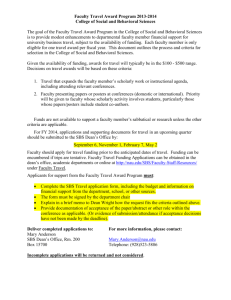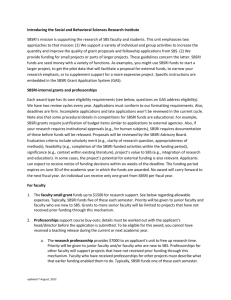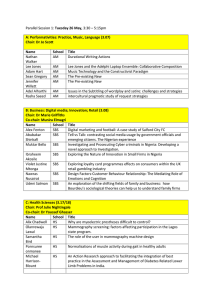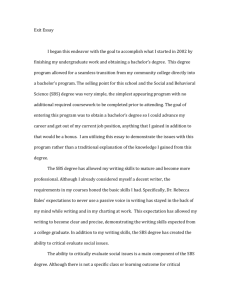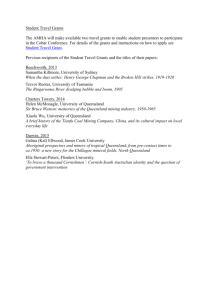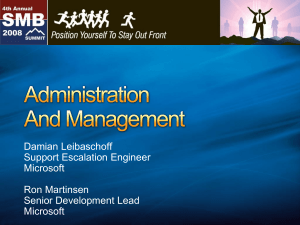Queensland Businesses - Moreton Bay Regional Council
advertisement
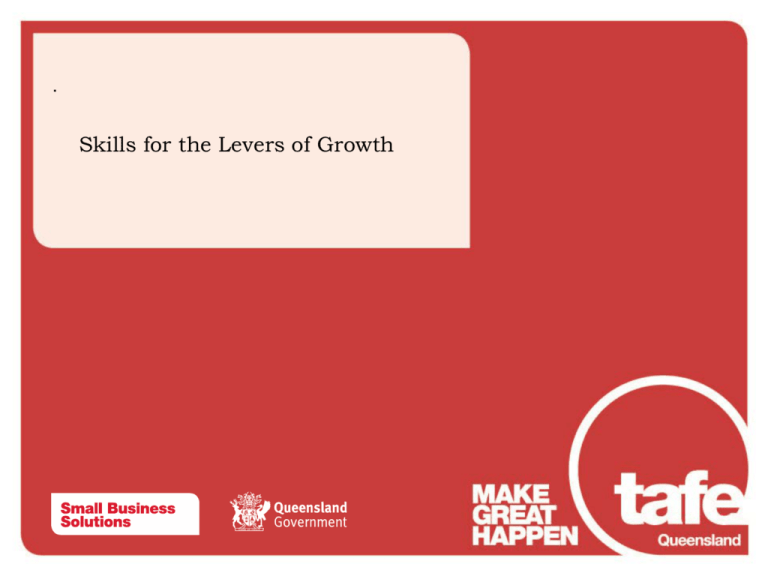
. Skills for the Levers of Growth Queensland Businesses Queensland Businesses Small Businesses = 95% of all businesses Source: ABS 2012 Queensland small business employ 4 out of 10 of the workforce and account for a third of the dollars earned by all Queensland businesses Queensland Small Businesses • 96% (395,797) of Queensland businesses have less than 20 employees. • Small businesses employ four in ten of the Queensland working population. • Accounts for three in ten dollars earned by all businesses. The top 3 industries; 1. Professional, Scientific and Technical Services (16%) - more likely to have marketing issues (67%) - management concerns (41%) 2. Hiring and Real Estate Services (13%) 3. Construction (12%) General concerns: Concerns on economic environment (44%) Government regulations (27) Source: Department of Tourism, Major Events, Small Business and The Commonwealth Games 2014 Small Business Solutions (SBS) • SBS provides a mentoring program for micro businesses (1- 4 employees) and small businesses (5-19 employees) to understand the concepts of starting and managing a small business in a practical workshop environment. • Participants receive vocational education and training qualifications – an advantage in a competitive knowledge economy. Micro Businesses – Certificate 3 in Micro Business Management Small Businesses - Certificate 4 in Small Business Management • The program is delivered by Mentors who have the knowledge and experience of running a small business, high qualifications, active in business networks. • Programmes delivered through series of workshops and one on one mentoring. Mentoring Programme • Participants attend 5 business workshops with a Mentor to establish the knowledge level and receive training where there are knowledge gaps. • The Mentor introduces the concepts and relates them to practical examples in the participants business. • The Mentor will assess the level of Recognition of Prior Learning (RPL) of each participants and provide gap training where necessary. • Participants are provided with notes and templates to assist them to understand the subjects and also as reference later. • Participants must successfully complete a business plan for their business as the assessment. Highlights of SBS Report – Strategy & Action plan 2013-2014 Testing of efficacy of SBS programmes - Participants in SBS programme between 2010 and 2013 - 423 respondents interviewed - Wide diversity; remote regions, owner/director characteristics, gender, Indigenous and non English speaking. - Various stages of business lifecycle - Industry sectors, including the four-pillar industries • 79 % felt their business was more resilient and able to survive and grow. • 62% felt the program helped maintain the number of employees. • 70% stated that the program helped to maintain profits at a higher level • 82 per cent of respondents felt that the gap in knowledge was addressed. Trends in Small Businesses Phase of development of the business when undertook SBS program Per cent1 Start-up: The business had only recently come into existence or only had an idea of planning to start a new business 34 Growth: Consumer demand was sharply increasing 27 Mature: The business was well established and experiencing steady growth 25 Static: There was little or no growth and there were no plans for expansion 10 Contracting: You had to cut costs to preserve profits and profits were weak 1 Percentages may not sum to 100 per cent due to rounding. 4 Highlights of SBS Report – Strategy & Action plan 2013-2014 Proportion of SME’s experiencing growth in the past 12 months (Prior to survey) __________________________________________________________________ Growth (%) Decline (%) SBS Qld* SBS Qld* _________________________________________________________________________________________ Employment 20 13 10 15 Sales 49 30 15 42 Profits 42 24 22 46 _________________________________________________________________________________________ *As measured by the Sensis Business Index, 2013 Highlights of SBS Report • Many small business operators consider training in business skills a low priority because of lack of knowledge of what training is required and available. • Often see informal training as adequate and place less priority on formal qualifications. • 72% of respondents would very likely recommend the SBS programme. • 70% of business operators would not have enrolled under a VET fee help arrangement. • 49% of business start ups in Queensland remain in operation after four years (ABS 2013a) • ASIC (2013) data on business insolvencies show the primary reason for business failure is poor strategic management. Specifically: - Compliance with regulations - Finance barriers - Management skills - Poor information resources Highlights of SBS Report – Strategy & Action plan 2013-2014 Causes of insolvencies (ASIC 2013) 1. 42% from poor strategic management. 2. 41% from inadequate cash flow 3. 32% from trading losses. These include; Poor business acumen and strategy; Poor leadership skills; Poor entrepreneurial skills; Poor business planning and organising skills; Poor financial management skills; Poor marketing strategy and competitor knowledge; and Poor understanding of compliance requirements such as industrial relations, work health and safety and WorkCover. Master Class Workshops Two Day Master Workshop Programs • Designed for businesses looking for specific skills improvement. Small business that are growing. - Marketing - Finance - Human Resources (HR) - Logistics & operations • Credits towards Diploma in Business Management.


